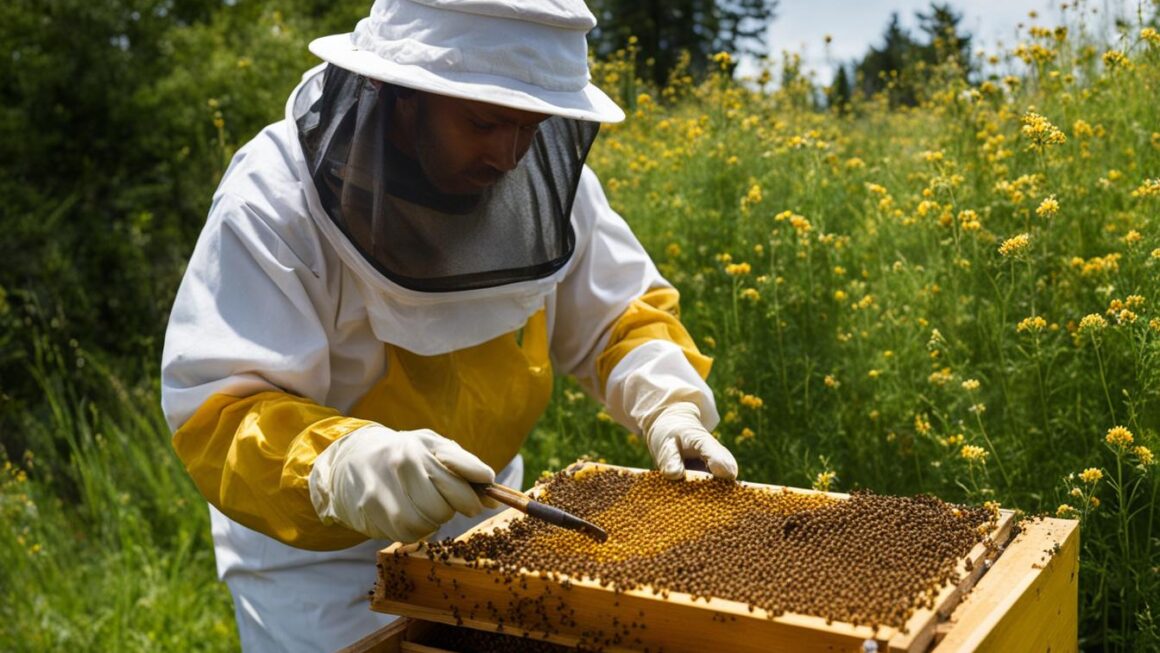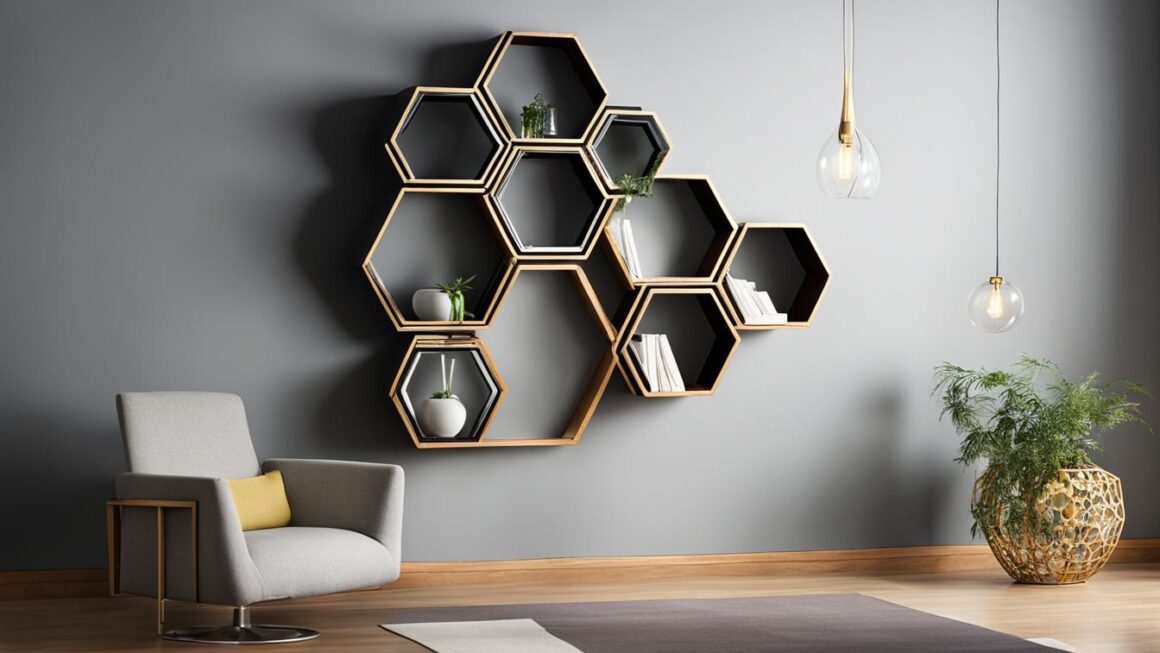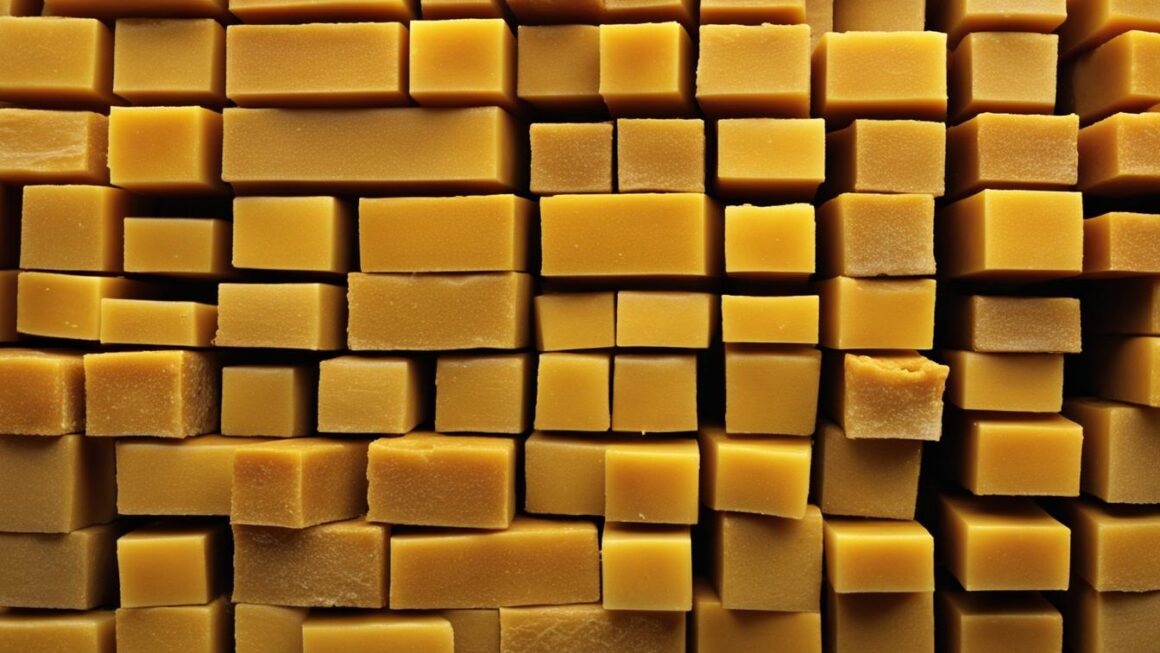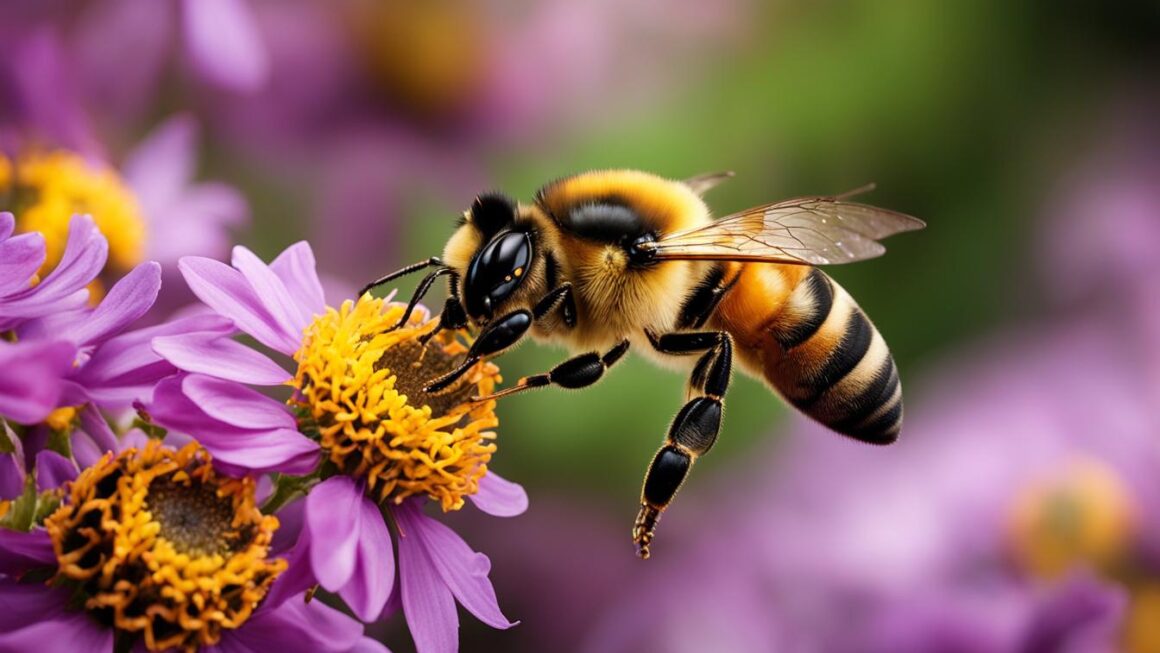Bee pollen is a valuable resource for honey bees, providing them with essential nutrients for their health and development. As a beekeeper, knowing how to collect bee pollen effectively is crucial for maximizing its benefits while ensuring the well-being of the bees. In this guide, we will explore various methods, techniques, and best practices for collecting bee pollen.
Key Takeaways:
- Understanding the importance of bee pollen for honey bees.
- Exploring different methods for collecting bee pollen, including the use of pollen traps.
- Implementing best practices to ensure successful and stress-free pollen collection.
- Ensuring the safety of bees during the collection process.
- Properly processing and storing collected bee pollen for longevity and quality.
The Importance of Bee Pollen for Honey Bees
Bee pollen plays a crucial role in the diet of honey bees, serving as a vital source of nutrition and contributing to the health and development of the entire colony. As bees forage for nectar and pollen, they collect tiny pollen grains from flowers, which adhere to their bodies due to their sticky nature. When bees return to the hive, they transfer the collected pollen to other worker bees, who then store it in specialized structures known as pollen baskets located on their hind legs.
The pollen collected by bees is rich in protein, fats, minerals, and vitamins, making it a valuable food source for the entire colony. It provides bees with essential nutrients necessary for brood rearing, including the production of royal jelly, a highly nutritious substance that is fed to both queen bees and young larvae. The availability of an adequate supply of pollen ensures the healthy development of larvae, the growth of the colony, and the longevity of individual bees.
Aside from its nutritional benefits, bee pollen also plays a crucial role in the pollination process. As bees move from flower to flower, pollen grains become attached to the stigma of flowers, enabling pollination and the subsequent reproduction of plants. This symbiotic relationship between bees and flowering plants is vital for maintaining biodiversity and the production of fruits, vegetables, and seeds.
The Role of Pollen in Brood Rearing
One of the key roles of bee pollen in the honey bee colony is its involvement in brood rearing. The protein and nutrients present in pollen are essential for the development of young bees. Nurse bees mix pollen with other secretions to form a nutritious paste called “bee bread,” which is fed to larvae. This protein-rich diet ensures proper growth, healthy development, and the overall vitality of the growing brood.
| Benefits of Bee Pollen for Honey Bees |
|---|
| Provides essential nutrients for brood rearing |
| Stimulates royal jelly production |
| Contributes to overall colony health and longevity |
| Plays a vital role in the pollination process |
| Supports biodiversity and plant reproduction |
The importance of bee pollen for honey bees cannot be overstated. Its nutritional value, role in brood rearing, and contribution to the overall health of the colony highlight the significance of preserving and ensuring an adequate supply of bee pollen for honey bee populations. As beekeepers, it is essential to understand the benefits of bee pollen and implement practices that support its availability and utilization in honey bee colonies.
Methods for Collecting Bee Pollen
Beekeepers have various methods at their disposal for collecting bee pollen. One common technique is the use of pollen traps, which selectively collect pollen from returning forager bees. These traps are installed at the hive entrance and allow the bees to enter the hive while scraping off the pollen from their legs. The collected pollen can then be easily extracted and collected for further use or sale.
Proper installation and maintenance of pollen traps are crucial for effective collection. The traps should be positioned correctly to ensure that they do not impede the bees’ access to the hive. It is essential to regularly monitor and clean the traps to prevent the accumulation of debris or excess pollen, which can lead to contamination. Care should be taken to avoid trapping too much pollen, as this may deprive the bees of their essential food source.
When using pollen traps, beekeepers must be mindful of the impact on the bees’ overall health and well-being. It is recommended to only use traps during periods of heavy pollen flow when there is an abundance of pollen available. This ensures that the bees have access to enough pollen for their own needs while still allowing for the collection of surplus pollen. Providing alternative pollen sources, such as pollen substitutes or diverse forage options, can also help mitigate any potential negative effects on the bees.
To summarize, pollen traps are an effective method for collecting bee pollen. By following proper installation and maintenance practices, beekeepers can ensure successful collection while prioritizing the health and nutrition of their bees.
Best Practices for Bee Pollen Collection
Effective bee pollen collection requires adherence to certain best practices to ensure maximum pollen collection and minimize stress on the bees. By following these tips, beekeepers can enhance their collection efforts while prioritizing the well-being of their honey bee colonies.
Here are some key best practices for bee pollen collection:
- Place pollen traps during periods of heavy pollen flow: By strategically positioning the traps when pollen sources are abundant, beekeepers can maximize their pollen collection. This ensures that the forager bees have ample opportunities to collect and store pollen.
- Regularly monitor and maintain the traps: It is important to regularly check the pollen traps to ensure they are functioning properly. Regular maintenance includes cleaning the traps and removing any debris that may obstruct the collection process.
- Provide alternative pollen sources: While collecting pollen, it is crucial to ensure that the bees have enough pollen for their own needs. Beekeepers should provide alternative sources of pollen, such as planting diverse flowering plants and trees near the hives. This helps prevent excessive stress on the bees during the collection process.
By implementing these best practices, beekeepers can optimize their pollen collection efforts while safeguarding the health and well-being of their honey bee colonies. Minimizing stress on the bees during pollen collection is essential for maintaining the long-term productivity and sustainability of the colonies.

Importance of Minimizing Stress on Bees during Pollen Collection
Minimizing stress on bees during pollen collection is crucial for the overall health and vitality of honey bee colonies. When bees experience excessive stress, it can affect their immune system, reproductive capabilities, and overall well-being. Stress can also lead to increased susceptibility to diseases and pests.
\”Minimizing stress on bees during pollen collection is crucial for the overall health and vitality of honey bee colonies.\”
Therefore, beekeepers should prioritize the use of gentle collection methods such as pollen traps, which allow bees to continue their foraging activities without significant disruption. Providing a balanced and diverse diet, ensuring adequate nutrition, and reducing environmental stressors are also essential for minimizing stress on bees during pollen collection.
| Best Practices for Bee Pollen Collection | Benefits |
|---|---|
| Placing traps during heavy pollen flow | Maximizes pollen collection |
| Regular maintenance of traps | Ensures proper functioning and efficiency |
| Providing alternative pollen sources | Reduces stress on bees and maintains colony health |
By following these best practices and prioritizing the well-being of the bees, beekeepers can successfully collect bee pollen while promoting the long-term health and productivity of their honey bee colonies.
Safety Considerations for Bee Pollen Collection
Bee pollen collection is an important task for beekeepers, but it is crucial to prioritize the safety and well-being of the bees during this process. By following certain safety considerations, beekeepers can ensure that both the bees and themselves are protected.
One key aspect of bee pollen collection safety is using traps that are designed to minimize damage to the bees. These traps should allow the bees to enter and exit without causing harm or stress. Proper ventilation and airflow within the hive are also important to provide a comfortable environment for the bees during the collection process.
Practicing good hygiene is another essential safety measure. Beekeepers should maintain cleanliness in the hive and regularly clean and sterilize the pollen traps to prevent the spread of diseases and pests. This helps to maintain the overall health of the colony and prevent any potential harm to the bees.
Protective clothing plays a vital role in ensuring safety during bee pollen collection. Beekeepers should wear appropriate protective gear, including a bee suit, gloves, and a veil, to minimize the risk of stings. Handling the bees with care and avoiding sudden movements can also help prevent injury to both the bees and the beekeepers.
By implementing these safety measures, beekeepers can collect bee pollen effectively while safeguarding the well-being of their bees. It is important to remember that the safety and health of the bees should always be the top priority in any beekeeping activity.
Safety Considerations for Bee Pollen Collection
| Safety Considerations | Details |
|---|---|
| Use bee-friendly traps | Choose traps designed to minimize harm to bees, allowing them to enter and exit without stress or damage. |
| Ensure proper ventilation | Maintain adequate airflow in the hive to provide a comfortable environment for the bees during the collection process. |
| Practice good hygiene | Clean and sterilize pollen traps regularly to prevent the spread of diseases and pests, ensuring colony health. |
| Wear protective clothing | Use appropriate beekeeping gear, including a bee suit, gloves, and a veil, to minimize the risk of stings. |
| Handle bees with care | Avoid sudden movements and handle the bees gently to prevent injury to both the bees and the beekeeper. |
Processing and Storage of Bee Pollen
Once bee pollen is collected, it is important to properly process and store it to maintain its quality and longevity. The following steps outline the recommended procedures for processing and storing collected bee pollen:
- Removal of Debris: Before processing, carefully remove any debris or unwanted particles from the collected bee pollen. This can be done by gently sifting it through a fine mesh screen or using specialized equipment designed for pollen cleaning.
- Drying the Pollen: To prevent spoilage and preserve the nutritional value of the pollen, it must be dried thoroughly. Spread the pollen in a thin layer on clean, dry surfaces such as trays or screens. Place them in a well-ventilated area away from direct sunlight. Stir the pollen occasionally to ensure even drying. The ideal moisture content for stored pollen is around 7-10%.
- Packaging for Storage or Sale: Once the pollen is completely dry, it should be stored in airtight containers to protect it from moisture and contaminants. Use food-grade containers made of glass or plastic that are clean and sterilized. Label each container with the collection date and any relevant information such as the pollen source or specific characteristics.
Properly processed and stored bee pollen can have a shelf life of up to two years if stored in a cool, dark place with stable temperature and humidity conditions. Regularly check the stored pollen for any signs of spoilage, such as mold or foul odor, and discard any contaminated batches.
Here is an example of a complete table illustrating the processing and storage steps for bee pollen:
| Processing and Storage Steps | Description |
|---|---|
| Removal of Debris | Remove any debris or unwanted particles from the collected bee pollen. |
| Drying the Pollen | Spread the pollen in a thin layer on clean, dry surfaces and allow it to dry thoroughly in a well-ventilated area away from direct sunlight. |
| Packaging for Storage or Sale | Store the dried pollen in airtight containers made of glass or plastic, labeled with relevant information, and store in a cool, dark place. |
By following these processing and storage guidelines, beekeepers can ensure the quality and marketability of their collected bee pollen, whether it is being used for personal consumption or for sale as a valuable bee product.
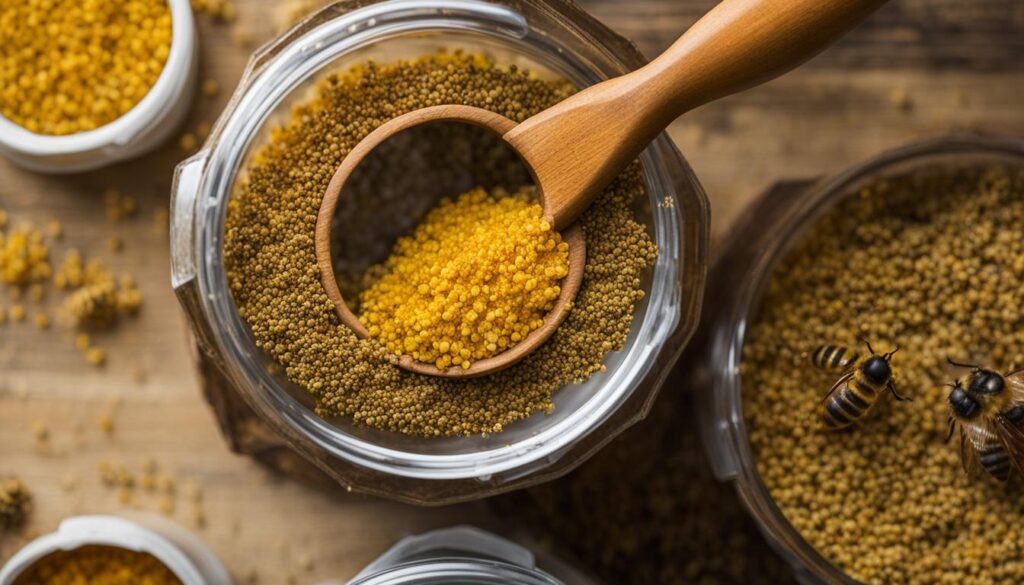
Bee Pollen Collection in Commercial Beekeeping Operations
Bee pollen collection in commercial beekeeping operations offers beekeepers an opportunity to diversify their hive products and generate additional income. Bee pollen is a marketable product that has gained popularity due to its nutritional benefits and potential health-related properties. Commercial beekeepers can capitalize on this demand by implementing efficient and sustainable bee pollen collection practices.
The process of bee pollen collection in commercial beekeeping involves strategically placing pollen traps during periods of heavy pollen flow. These traps are designed to selectively collect pollen from returning forager bees without causing harm or stress to the colony. Once collected, the pollen is carefully processed to remove any impurities or debris, ensuring a high-quality product for sale or consumption.
Bee pollen is sought after by various industries, including the dietary supplement and cosmetic sectors. It is rich in protein, vitamins, minerals, and antioxidants, making it a valuable ingredient in health and wellness products. Commercial beekeepers can establish partnerships with local businesses or sell directly to consumers, leveraging the marketability of bee pollen to boost their revenue.
| Benefits of Bee Pollen Collection in Commercial Beekeeping |
|---|
| Bee pollen serves as a valuable source of additional income for beekeepers. |
| It allows beekeepers to diversify their hive products and expand their market offerings. |
| Bee pollen has a growing demand in industries such as dietary supplements and cosmetics. |
| Collection and sale of bee pollen can help offset the costs of beekeeping operations. |
| Commercial beekeepers can establish relationships with local businesses and consumers through bee pollen sales. |
Overall, bee pollen collection in commercial beekeeping provides an avenue for beekeepers to maximize the value of their honey bee colonies. By capitalizing on the marketability of bee pollen and implementing sustainable collection practices, beekeepers can not only generate additional income but also contribute to the growth and success of the beekeeping industry as a whole.
Bee Pollen Collection and Environmental Sustainability
Bee pollen collection is not only essential for beekeepers but also has an environmental impact. It is crucial to adopt responsible and sustainable practices to minimize the negative effects on the surrounding ecosystem. By prioritizing the health and well-being of both bees and the environment, beekeepers can ensure the long-term sustainability of bee pollen collection.
Responsible beekeeping practices include providing adequate pollen sources for bees. This involves maintaining a diverse range of flowering plants in the vicinity of the hives, ensuring a consistent and nutritious supply of pollen for the bees to forage. By offering a variety of pollen sources, beekeepers can prevent overexploitation of any single plant species and help maintain biodiversity in the area.
Another important aspect of sustainable bee pollen collection is avoiding the use of harmful chemicals and pesticides. Chemical residues in pollen can have detrimental effects on bee health and colony productivity. Beekeepers should opt for natural and organic methods of pest and disease control, minimizing the impact on both bees and the surrounding environment.
In addition, responsible beekeepers actively contribute to the conservation and restoration of natural habitats. By supporting initiatives that protect and create bee-friendly habitats, such as planting wildflowers or participating in conservation projects, beekeepers can contribute to the overall health of the ecosystem and provide bees with ample opportunities to collect pollen naturally.
The Environmental Impact of Bee Pollen Collection
The environmental impact of bee pollen collection is multifaceted. While it is an important resource for honey bees, excessive collection without considering the sustainability of pollen sources can have negative consequences. Overexploitation of specific plant species can lead to a loss of biodiversity and disrupt the delicate balance of local ecosystems.
Furthermore, the use of pesticides and chemicals in agriculture can contaminate the pollen that bees collect, posing risks to bee health and potentially impacting other pollinators and wildlife. It is crucial for beekeepers to be aware of the potential environmental impact of their practices and take steps to mitigate any negative effects.
Overall, sustainable and responsible bee pollen collection is vital for the well-being of bees and the environment. By adopting practices that prioritize the health and diversity of pollen sources, minimize the use of chemicals, and contribute to habitat conservation, beekeepers can play a crucial role in ensuring the long-term sustainability of this important resource.
Conclusion
In conclusion, bee pollen collection is a vital practice in beekeeping that offers numerous benefits for both beekeepers and honey bees. By following best practices, beekeepers can effectively collect bee pollen while ensuring the well-being of their bees. It is important to prioritize safety during the collection process, using traps that minimize damage to the bees and practicing good hygiene to prevent the spread of diseases and pests.
Additionally, beekeepers should consider the environmental impact of bee pollen collection and adopt sustainable practices. This includes providing adequate pollen sources for bees, avoiding overexploitation of natural resources, and promoting the overall health and well-being of both bees and the environment.
Proper processing and storage techniques are essential to maintain the quality and marketability of collected bee pollen. By removing debris, drying the pollen, and packaging it appropriately, beekeepers can ensure the longevity and value of their collected pollen. With the right knowledge, practices, and consideration for safety and sustainability, beekeepers can maximize the benefits of bee pollen collection for themselves and their bees.
FAQ
What is the importance of bee pollen for honey bees?
Bee pollen provides essential nutrients for brood rearing and overall colony health. It stimulates the production of royal jelly and is necessary for the development of queen bees and young larvae.
What are the methods for collecting bee pollen?
Beekeepers can use pollen traps to selectively collect pollen from returning forager bees. The trapped pollen can then be extracted and collected for various purposes.
What are some best practices for bee pollen collection?
Beekeepers should place pollen traps during periods of heavy pollen flow, regularly monitor and maintain the traps, and provide alternative pollen sources for bees. Minimizing stress on the bees during the collection process is also important.
What safety considerations should be taken during bee pollen collection?
Beekeepers should use traps that minimize damage to the bees, ensure proper ventilation and airflow within the hive, practice good hygiene to prevent diseases and pests, and use protective clothing while handling bees.
How should bee pollen be processed and stored?
Bee pollen should be processed by removing debris and unwanted particles, dried to prevent spoilage, and packaged in suitable containers for storage or sale.
Can bee pollen collection be done in commercial beekeeping operations?
Yes, beekeepers in commercial operations can collect and sell bee pollen as a marketable product, offering an additional source of income and diversifying hive products.
What are the environmental sustainability considerations for bee pollen collection?
Beekeepers should adopt responsible and sustainable practices, such as ensuring adequate pollen sources for bees, avoiding overexploitation of natural resources, and practicing methods that promote the overall health of bees and the environment.

